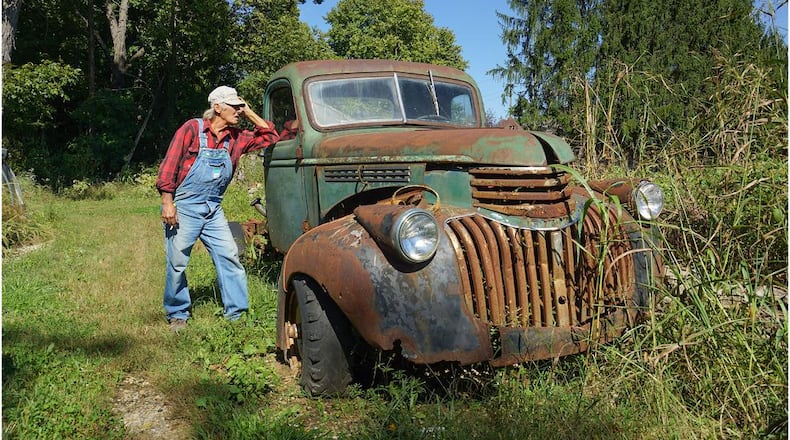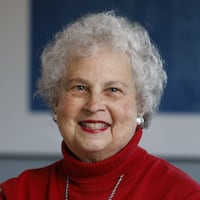Aren’t we lucky to have America’s most extensive photography event right here in our backyard!?
“The fact that people can sign up for a free Passport that gets them into more than 100 exhibitions and projects and talks is bananas!” said the Dayton Art Institute’s Mariah Postlewait, the museum’s curator of photography. “Normally you’d have to pay to get into our museum but if you have a FotoFocus passport you get in for free!”
In addition to photo exhibitions, every venue is required to have at least one special program or event in connection with the exhibit.
There are also free Spotlight bus tours that visit a number of exhibits in one geographic location. On that day, artists and curators are on site for talks, tours, special events, and featured programming. A Dayton tour is slated for Saturday, Oct. 26. While the bus is now full, those interested could follow the route in their cars.
This year’s theme is “Backstories.” Participants were asked to examine the ways in which our perception of a photo changes when we know what happened before or after the image was taken. And conversely, the ways a photograph can challenge our ideas of a moment or event or historical truth. How might it disrupt a commonly held belief?
Featured attraction: Ansel Adams
Daytonians may remember Katherine Ryckman Siegwarth, a member of the Dayton Art Institute’s curatorial team from 2014-2021 who now serves as executive director of FotoFocus.
Siegwarth vividly remembers visiting the Dayton Art Institute with her grandmother at age 12 and gazing at the famous Ansel Adams (1902-1984) photograph, “Moonrise, Hernandez, New Mexico.”
“That moment has had lasting effects on my career as an art historian who specializes in the history of photography,” Siegwarth said years ago.
How fitting that the same iconic photo is one of the featured attractions of this year’s FotoFocus which Siegwarth oversees. It’s currently one of 80 photographs on display at the Cincinnati Art Museum where a traveling Ansel Adams Retrospective is making its first stop.
The Adams exhibit comes from the Center of Creative Photography in Tucson where the famous photographer’s archives are housed. “Discovering Ansel Adams,” which will be on view through Jan. 19, 2025, allows us to journey through the life of a young man who got his first Kodak Brownie camera in 1916 at the age of 14 and first used it when his family vacationed at Yosemite National Park in California. You’ll even see a facsimile of his first photo album from that trip.“
We actually watch him learn photography, and see the steps he took,” said Rebecca Senf, foremost Adams scholar who was the organizing curator for this exhibit and serves as chief curator for the Center for Creative Photography. In town for the opening, Senf said she has been devoted to Adams’ work since she was in college and is the author of “Making A Photographer: The Early Work of Ansel Adams.” Senf said the photographer was always excited about backpacking and going to the peaks of mountains. He particularly kept going back to Yosemite.
You’ll discover Adams also seriously studied piano and once compared a photographic negative to the composer’s score and the print to the score’s performance. Scan the CR Code on the gallery wall and you can access a playlist of the music Adams enjoyed, including some of his own.
Senf describes Adams as an only child who was very social and valued community and connections.
“He was a warm and curious person who served as a mentor to others and was a lifelong learner,” she said. “He dropped out of school when he was 12 and his parents hired private tutors to teach him. They bought him a year-long pass to the 1915 World’s Fair in San Francisco, where they lived.”
Credit: CONTRIBUTED
Credit: CONTRIBUTED
Though he originally planned to be a pianist, Adams eventually worked at his photography seven days a week but stopped every day at 5 p.m. for a happy hour. In the 1970s he was quite famous and was on the cover of Time magazine in 1976. Only recently, the U.S. postal service released an Ansel Adams stamp that features some of Adams’ most famous images in his signature “straight photography” style, “an approach defined by its precision and directness.” You’ll see many of those original photos in the Cincinnati exhibition which runs through Jan. 19, 2025.
Senf said she’s thrilled to have museum visitors learn more about Adams.
“This show humanizes him and is an invitation to learn more about him,” she said. “Sometimes we think famous people come into the world already knowing everything. This exhibit is chronological and shows how he progresses. How he learns about optics, how he transitioned into a mature style of panoramic sweeps of landscapes, how he began using light and weather effects that give his photos an emotional impact, and how he persuades his viewers about the importance of their experiences in the natural world.”
Here’s a sampling of other exhibits in our area:
Juan-Si Gonzalez, a Cuban-born artist who now lives in Dayton, is currently featured at the Herndon Gallery at Antioch College. The gallery has been involved with FotoFocus since 2012.
The piece Gonzalez is presenting is entitled “Looking for Cuba Inside.” Since 2001, Gonzalez has been going around the United States to different cities called Cuba.
“He photographs the places and photographs himself in those places,” said Michael Casselli, the gallery’s creative director. “There are also black and white photos that run around the whole gallery that are images related to feelings of dislocation. He’s a Cuban artist who can’t return to his homeland.”
Credit: CONTRIBUTED
Credit: CONTRIBUTED
The Dana L. Wiley Gallery, in the Front Street Building in downtown Dayton, is focusing on the work of Gary Beeber, an artist/filmmaker/photographer from Centerville. It’s the first time he’s been involved with FotoFocus.
When Beeber learned the theme of FotoFocus was backstories, he decided to revisit a film he’d made about a local organic farmer, Michael Malone.
“He’s a native Daytonian who now lives in Centerville, and I’d done a documentary about him three years ago that told the backstory of his Hungry Toad Farm,” Beeber said. “I filmed in detail how they grew the lettuce – from the seed to the harvest. I talked about their organic eggs and vegetables.”
Because photo technology has changed so much in the past three years, Beeber decided to add scenes to the previous film. He was also intrigued with Malone’s partner Nancy Kelly, who grows organic flowers.
“They are beautiful dahlias covered with netting and it looked so weird I made a series of photographic prints of them,” he said.
Rosewood Arts Center is showing two solo exhibitions for FotoFocus, both by photographers who don’t work with cameras, but with light, shadow and exposure.
“They are both using early lensless forms of the photographic process,” said Shayna McConville, cultural arts manager for the city of Kettering.
The two artists were selected by Paula Willmot Kraus, former gallery coordinator for Rosewood who passed away in November of 2023.
“Paula was a prolific photographer who always had a number of photography-based artists she was interested in,” McConville said. “She had written the proposal for FotoFocus and had chosen these two photographers.”
Credit: CONTRIBUTED
Credit: CONTRIBUTED
Michael Reese uses a cyanotype process.
“It’s an exposure process similar to sunprints,” McConville explained. “They are on watercolor paper, then he mounts them on wood and adds pen and ink. He uses images of states in America and on top of those he draws celestial maps that were used by enslaved people in that state to escape.”
Credit: MICHAELREESESTUDIOS
Credit: MICHAELREESESTUDIOS
The other Rosewood exhibit is by Cara Lee Wade who creates lumen prints. Plant materials are placed on top of photographic paper.
“They are then exposed to the light from a darkroom enlarger or the sun and the result is so dense and rich and imaginative,” McConville said.
Rosewood is also showing a series of works by Kraus that she was preparing before she died.
“Her friends helped print them so she could have that final show,” McConville added. “It’s called ‘Were I a Bird.’”
Credit: CONTRIBUTED
Credit: CONTRIBUTED
At the DAI
The aforementioned Postlewait has curated the DAI exhibition entitled “Devil’s Promenade.”
“It is a project that was created by two photographers who work as a duo,” she said. “Lara Shipley and Antone Bolezal are both from the Ozarks and spent 10 years on this project. I heard them speak 10 years ago at a conference for the Society for Photographic Education. They’re wonderful speakers and the imagery is fascinating and puzzling and really draws you in.”
The two photographers will be in Dayton for an artist talk and reception on Oct. 18. The event is free to those who have registered for a free FotoFocus Passport.
“The exhibition is a lot about storytelling and what it means to be from this place, how people, the land, and religion all relate to one another,” Postlewait said. “There’s sound in one of the galleries and visitors will be able to listen to people from the Ozarks telling stories. There’s also some folklore and myths so there’s a spooky element also.”
Another interesting aspect of this exhibit is that one of the photographers lives in Michigan and the other in Nevada. They met in a space far away from the Ozarks; when they realized they were both from the Ozarks they began the joint project.
Credit: JACOB DRABIK
Credit: JACOB DRABIK
Big plans for FotoFocus
Siegwarth said FotoFocus is hoping to be in its new building next year. The private gallery space will host year-round exhibits and will continue its signature events including an annual spring lecture, annual symposia, and, of course, FotoFocus.
“FotoFocus is always striving to inspire conversation and curiosity,” Siegwarth said. “If any of the projects lead to conversation among friends or inspires people to do more research, it’s done something right. Maybe they will visit a place they’ve never been to before and learn about the wonderful programming they do.”
HOW TO GO
To register for a free Passport and see the listings of venues and exhibits, visit fotofocus.org.
About the Author








